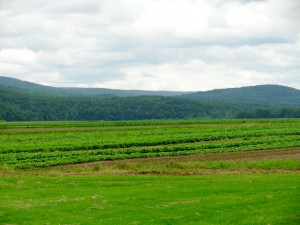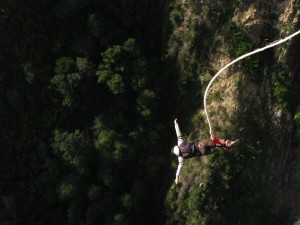Hello all,
Time is going by quickly in my internship at Geneva. We’re starting to gain speed on a lot of projects relating to mustard, pumpkins, cucumbers, broccoli, buckwheat, and cover crops.
Isn’t buckwheat pretty? No wonder Thomas likes it so much!

Recently, we’ve been taking a panoply of different measurements and getting exposed to different tasks without the help of our supervisor. One of the more interesting devices that Liz and I have gotten to use is a penetrometer- an device (sort of shaped like a T) that measures density of the soil that you are growing plants on. In order to use it, one has to insert the penetrometer into the soil and note a reading that appears on a dial at the top. The trick with the penetrometer is to not take all of the measurements by yourself! It seems fun at first, and the fun doesn’t diminish as you crazily stab the metal instrument into the ground, but it sure gets tiring. So it makes sense to trade off with a partner so your penetrometer doesn’t take the brunt of the damage.
What we’re starting to see so far with the penetrometer readings is that areas where a cover crop has been grown tend to be a little bit more aggregated due to root structures of the cover crop (like our dear old buckwheat). Soil is a pretty interesting indication of how healthy your plants are going to turn out–if there is a hardpan, i.e. a really bad crust from poor soil management, your crops aren’t going to turn out so well. What Thomas Bjorkman is researching is the impact of these cover crops on a variety of soil health issues.
Last week, Liz and I actually got to hop on the tractor and plant Bolo pumpkins for a study involving the impact of allelopathic mustards on pumpkin plants. It was pretty exciting, not going to lie, to drive a tractor super slow down half a length of a small field. You feel pretty powerful sitting up there being in command of a machine with a lot of horsepower! There are a lot of safety aspects to remember though. Perhaps the most important thing we learned was to keep our hands away from any moving equipment, chains, and gears (duh) and to push in the clutch at the first sign of any emergency. We’re pros now!
Last, today was an interesting study in both resourcefulness and amazing agricultural technology. In setting up drip irrigation for a plot of broccoli (which our boss insisted must be kept both immaculate and gorgeous), we learned about how important gravity is in making any system with water work properly. Also, keep kinks out of any hoses! Our broccoli was happy once our irrigation system was both properly lined up and kink-free.
For bigger fields, we utilized a much more complex tool. Our supervisor, Joe, hitched a large traveling irrigation cart to our van, drove it out to the field, and then left it in the middle of the field. The head of the apparatus, which looks like a common sprinkler, jettisons about 300 or so gallons of water per minute (or something like that, I think I was a little lost in the details) to a buckwheat patch. The head is on a rolling cart on wheels, which is attached to a water hose, which lies down the length of the field and is wound around a huge spool of sorts. As the field gets watered, the spool retracts hose into itself, pulling the cart with the sprinkler down the length of the field. It’s pretty cool! I’ll attach a picture so that my confusing definition doesn’t get more confusing. 
Well folks, that’s all for today! Liz and I barely made it alive out of a large thunderstorm, so I’m counting my lucky stars I’m able to blog to you about our busy days in Geneva. More posts coming soon!










